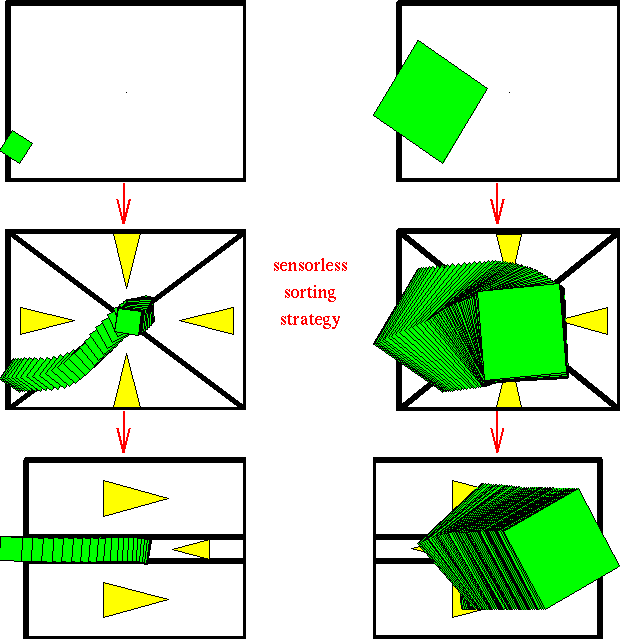Projects Archive
Programmable Force Fields - Sensorless Positioning, Orienting, and Sorting (1992-1997)
Team Members
Karl F. Böhringer, Bruce R. Donald (Cornell)
Summary
Increased miniaturization of mass-produced products such as disk drives, displays, and sensors will require fundamental innovations in design and parts handling. Many of the components in these products will be integrated circuits and MEMS (Micro Electro Mechanical Systems) fabricated with massively parallel wafer processing technology. Conventional pick and place robotic techniques are inadequate for the efficient assembly of these micron-scale components. This new economy of scale poses a fundamental challenge for design and assembly. We propose an entirely new methodology founded on recent insights from sensorless and minimalist robotics: massively parallel manipulation.
The idea is to move parts using planar forces and moments that require a minimum of sensing and servoing. The shape of the field, as defined by the magnitude and direction of force at each point, can be designed to position, align, sort, and assemble arrays of small parts in parallel.
The key to our approach is the programmable force field (PFF), an abstraction defined with piecewise continuous functions on the plane, that can be locally integrated to model the motion of parts interacting with the plane. In the past two years, the PIs have used variants of this abstraction to model different methods for implementing forces, such as arrays of microactuators and vibrations of a plate. This abstraction is also related to the theory of vector and potential fields that are used to model fluid dynamics and hold great promise for modelling electrostatic forces and compliant motion due to contact with rigid obstacles.
Recently, a new class of manipulators has been developed at the micro-scale based on MEMS technology (Micro Electro Mechanical Systems fabricated from silicon). These devices are both massively parallel (thousands of devices on a chip) and extremely fast (motion cycles measured in micro-seconds). Applying traditional digital control techniques would require increasing controller CPU speeds by 6 orders of magnitude. Instead we propose to develop techniques to allow real-time control of MEMS manipulators with present-day computational hardware.
Videos
Selected Publications
-
K. F. Böhringer, B. R. Donald, Lydia Kavraki, Florent Lamiraux, "Part Orientation with One or Two Stable Equilibria Using Programmable Vector Fields." IEEE Transactions on Robotics and Automation, 16(2):157-170, April 2000. Paper.
-
K. F. Böhringer, B. R. Donald, N. C. MacDonald, "Programmable Vector Fields for Distributed Manipulation, with Applications to MEMS Actuator Arrays and Vibratory Parts Feeders." International Journal of Robotics Research, 18(2):168-200, February 1999. Paper.
-
K. F. Böhringer, B. R. Donald, N. C. MacDonald, G. T. A. Kovacs, J. W. Suh, "Computational Methods for Design and Control of MEMS Micromanipulator Arrays." IEEE Computational Science and Engineering, 4(1):17-29, January-March 1997. Paper.
A complete list of our publications (many of them available online) can be found here.
Acknowledgements
-
NSF IRI-8802390, IRI-9000532, IRI-9201699, IRI-9530785, and CISE/CDA 98-05548 IRI-9896020, and by a Presidential Young Investigator award to Bruce Donald, NSF/ARPA SGER IRI- 9403903
-
AFOSR, the Mathematical Sciences Institute, Intel Corporation, and AT&T Bell Laboratories


